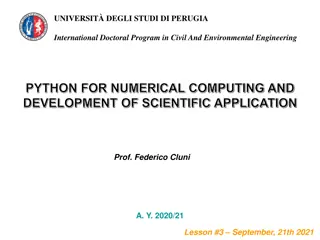
Understanding NumPy Array Creation and Manipulation
Learn about NumPy, the core library for scientific computing in Python, with a focus on creating and manipulating 1D arrays. Explore the basics of array creation, element modification, and the differences between NumPy arrays and Python lists.
Download Presentation

Please find below an Image/Link to download the presentation.
The content on the website is provided AS IS for your information and personal use only. It may not be sold, licensed, or shared on other websites without obtaining consent from the author. If you encounter any issues during the download, it is possible that the publisher has removed the file from their server.
You are allowed to download the files provided on this website for personal or commercial use, subject to the condition that they are used lawfully. All files are the property of their respective owners.
The content on the website is provided AS IS for your information and personal use only. It may not be sold, licensed, or shared on other websites without obtaining consent from the author.
E N D
Presentation Transcript
NUMPY -ARRAY NumPy stands for Numerical Python.It is the core library for scientific computing in Python. It consist of multidimensional array objects, and tools for working with thesearrays. Arrays Numpy Array is a grid of values with same type, and is indexed by a tuple of nonnegative integers. The number of dimensions of it ,is the rank of the array; the shape of an array depends upon a tuple of integers giving the size of the array along each dimension. Note:- Befor numpy based programming ,it must be installed. It can be installed using >pip install numpy command at command prompt
NUMPY -ARRAY 1 DARRAY Any arrays can be single or multidimensional. The number of subscript/index determines dimensions of the array. An array of one dimension is known as a one-dimensional array or 1-D array In above diagram num is an array ,it s first element is at 0 index position ,next element is at 1 and so on till last element at n-1 index position.At 0 index position value is 2 and at 1 index position value is 5.
NUMPY -ARRAY 1 DARRAY Creation of 1D array One dimension array can be created using array method with list object with one dimensional elements. e.g.program # Create a 1D Array # Prints "<class 'numpy.ndarray'>" # Prints "(3,)" means dimension of array # Prints "500 200 300" # Change an element of the array import numpy as np a = np.array([500, 200, 300]) print(type(a)) print(a.shape) print(a[0], a[1], a[2]) a[0] = 150 print(a)
NUMPY -ARRAY 1 DARRAY Creation of 1D array Using functions import numpy as np p = np.empty(5) # Create an array of 5 elements with random values print(p) a1 = np.zeros(5) print(a1) # Create an array of all zeros float values # Prints "[0. 0. 0. 0. 0.]" a2 = np.zeros(5, dtype = np.int) print(a2) # Create an array of all zeros int values # Prints "[0. 0. 0. 0. 0.]" b = np.ones(5) print(b) # Create an array of all ones # Prints "[1. 1. 1. 1. 1.]" c = np.full(5, 7) # Create a constant array print(c) # Prints "[7 7 7 7 7]" e = np.random.random(5) print(e) # Create an array filled with random values
NUMPY -ARRAY NUMPYARRAY LIST 1 DARRAY Difference between Numpy array and list homogeneous (same) types. Python list support adding and removing elements. Numpy Array works on Python list are made up for heterogeneous (different) types. numpy.Array does not support addtion and removal of elements. Can t contain elements of different types Can contain elements of different types Less memory consumption More memory consumption Faster runtime execution. Runtime execution is comparatively slower than Arrays.
NUMPY -ARRAY 1 DARRAY Create 1D from string import numpy as np data =np.fromstring('1 2', dtype=int, sep=' ') print(data) Note:- in fromstring dtype and sep argument can be changed. Create 1D from buffer numpy array from range numpy.arange(start, stop, step, dtype) #program 1 import numpy as np x = np.arange(5) #for float value specify dtype = float as argument print(x) #print [0 1 2 3 4] #program 2 import numpy as np x = np.arange(10,20,2) print (x) #print [10 12 14 16 18]
NUMPY -ARRAY 1 DARRAY Create 1D from array Copy function is used to create the copy of the existing array. e.g.program import numpy as np x = np.array([1, 2, 3]) y = x z = np.copy(x) x[0] = 10 print(x) print(y) print(z) Note that, when we modify x, y changes, but not z:
NUMPY -ARRAY 1 D ARRAY SLICES Slicing of numpy array elements is just similar to slicing of list elements. e.g.program import numpy as np data = np.array([5,2,7,3,9]) print (data[:]) print(data[1:3]) print(data[:2]) print(data[-2:]) #print [5 2 7 3 9] #print [2 7] #print [5 2] #print [3 9]
NUMPY -ARRAY 1 D ARRAY JOINING Joining of two or more one dimensional array is possible with the help of concatenate() function of numpy object. e.g.program import numpy as np a = np.array([1, 2, 3]) b = np.array([5, 6]) c=np.concatenate([a,b,a]) print(c) #print [1 2 3 5 6 1 2 3]
NUMPY -ARRAY Print all subsets of a 1DArray If A {1, 3, 5}, then all the possible/proper subsets of A are { }, {1}, {3}, {5},{1, 3}, {3, 5} e.g.program import pandas as pd import numpy as np def sub_lists(list1): # store all the sublists sublist = [[]] # first loop for i in range(len(list1) + 1): # second loop for j in range(i + 1, len(list1) + 1): # slice the subarray sub = list1[i:j] sublist.append(sub) return sublist x = np.array([1, 2, 3,4]) # driver code print(sub_lists(x)) OUTPUT [[], array([1]), array([1, 2]), array([1, 2, 3]), array([1, 2, 3, 4]), array([2]), array([2, 3]), array([2, 3, 4]), array([3]), array([3, 4]), array([4])]
NUMPY -ARRAY Basic arithmetic operation on 1DArray e.g.program Aggregate operation on 1D Array e.g.program import numpy as np x = np.array([1, 2, 3,4]) y = np.array([1, 2, 3,4]) z=x+y print(z) #print [2 4 6 8] z=x-y print(z) #print [0 0 0 0] z=x*y print(z) #print [ 1 4 9 16] z=x/y print(z) #print [1. 1. 1. 1.] z=x+1 print(z) #print [2 3 4 5] import numpy as np x = np.array([1, 2, 3,4]) print(x.sum()) #print 10 print(x.min()) #print 1 print(x.max()) #print 4 print(x.mean())#print 2.5 print(np.median(x))#print 2.5
2 DARRAY An array of two dimensions/indexes/subscripts dimensional array or 2-D array is known as a two- In above diagram num is an array of two dimensions with 3 rows and 4 columns.subscript of rows is 0 to 2 and columns is 0 to 3.
NUMPY -ARRAY 2 DARRAY Creation of 2D array Two dimension array can be created using array method with list object with two dimensional elements. e.g.program import numpy as np a = np.array([[3, 2, 1],[1, 2, 3]]) print(type(a)) print(a.shape) print(a[0][1]) a[0][1] = 150 print(a) # Create a 2D Array # Prints "<class 'numpy.ndarray'>" # Prints (2, 3) # Prints 2 # Change an element of the array # prints [[ 3 150 1] [ 1 2 3]]
NUMPY -ARRAY 2 DARRAY Creation of 2D array Using functions import numpy as np p = np.empty([2,2]) print(p) # Create an array of 4 elements with random values a1 = np.zeros([2,2]) print(a1) # Create 2d array of all zeros float values # Prints [[0. 0.][0. 0.]] a2 = np.zeros([2,2], dtype = np.int) print(a2) # Prints [[0 0] [0 0]] # Create an array of all zeros int values b = np.ones([2,2]) print(b) # Create an array of all ones # Prints [[1. 1.] [1. 1.]] c = np.full([2,2], 7) # Create a constant array print(c) # Prints [[7 7] [7 7]] e = np.random.random([2,2]) print(e) # Create 2d array filled with random values
NUMPY -ARRAY 2DARRAY Creation of 2D array from 1D array We can create 2D array from 1d array using reshape() function. e.g. program import numpy as np A = np.array([1,2,3,4,5,6]) B = np.reshape(A, (2, 3)) print(B) OUTPUT [[1 2 3] [4 5 6]]
NUMPY -ARRAY 2 D ARRAY SLICES Slicing of numpy 2d array elements is just similar to slicing of list elements with 2 dimension. e.g.program import numpy as np A= np.array([[7, 5, 9, 4], [ 7, 6, 8, 8], [ 1, 6, 7, 7]]) print(A[:2, :3]) print(A[:3, ::2]) position print(A[::-1, ::-1]) print(A[:, 0]) print(A[0, :]) print(A[0]) #print elements of 0,1 rows and 0,1,2 columns #print elements of 0,1,2 rows and alternate column #print elements in reverse order #print all elements of 0 column #print all elements of 0 rows #print all elements of 0 row
NUMPY -ARRAY 2 D ARRAY JOINING e.g.program import numpy as np A= np.array([[7, 5], [1, 6]]) # concatenate along the first axis print(np.concatenate([A, A])) # concatenate along the second axis (zero-indexed) OUTPUT [[7 5] [1 6] [7 5] [1 6]] print(np.concatenate([A, A], axis=1)) x = np.array([1, 2]) # vertically stack the arrays print(np.vstack([x,A])) # horizontally stack the arrays y = np.array([[99], [99]]) print(np.hstack([A, y])) [[7 5 7 5] [1 6 1 6]] [[1 2] [7 5] [1 6]] [[ 7 5 99] [ 1 6 99]]
NUMPY -ARRAY 2 D ARRAY ARITHMATIC OPERATION Arithmetic operation add,substract,multiply,divide () functions. E.G.PROGRAM import numpy as np a = np.array([[7, 5, 9], [ 2, 6, 8]]) print(a) b = np.array([10,10,10]) c=np.add(a,b) # c=a+b, similar print(c) c=np.subtract(a,b) # c=a-b, similar print(c) c=np.multiply(a,b) # c=a*b, similar print(c) c=np.divide(a,b) # c=a/b, similar print(c) Note:- 1. if both 2d arrays are with same dimension[matrix form] then one to one arithmetic operation will be performed. 2. No of elements of a dimension must match otherwise error message thrown over 2d array is possible with OUTPUT [[7 5 9] [2 6 8]] [[17 15 19] [12 16 18]] [[-3 -5 -1] [-8 -4 -2]] [[70 50 90] [20 60 80]] [[0.7 0.5 0.9] [0.2 0.6 0.8]]






















